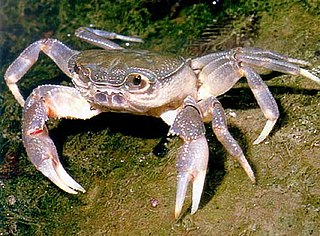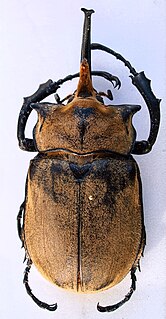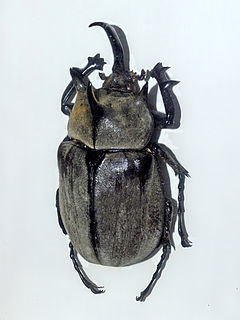
A carnivore, meaning "meat eater", is an animal whose food and energy requirements derive solely from animal products whether through hunting or scavenging. Animals that depend solely on animal flesh for their nutrient requirements are called hypercarnivores or obligate carnivores, while those that also consume non-animal food are called mesocarnivores or facultative carnivores. Omnivores also consume both animal and non-animal food, and apart from the more general definition, there is no clearly defined ratio of plant vs. animal material that would distinguish a facultative carnivore from an omnivore. A carnivore at the top of the food chain, not preyed upon by other animals, is termed an apex predator.

Johann Friedrich Wilhelm Herbst was a German naturalist and entomologist from Petershagen, Minden-Ravensberg. He served as a chaplain in the Prussian army. His marriage in Berlin, 1770, with Euphrosyne Luise Sophie (1742–1805), daughter of the Prussian Hofrat Libert Waldschmidt seems to have been childless.

Dynastinae or rhinoceros beetles are a subfamily of the scarab beetle family (Scarabaeidae). Other common names – some for particular groups of rhinoceros beetles – include Hercules beetles, unicorn beetles or horn beetles. Over 1500 species and 225 genera of rhinoceros beetles are known.
The corpuscles of Herbst or Herbst corpuscles are nerve-endings similar to the Pacinian corpuscle, found in the mucous membrane of the tongue, in pits on the beak and in other parts of the bodies of birds. They differ from Pacinian corpuscles in being smaller and more elongated, in having thinner and more closely placed capsules, and in that the axis-cylinder in the central clear space is encircled by a continuous row of nuclei. They are named after the German embryologist Curt Alfred Herbst.

Wheat germ oil is extracted from the germ of the wheat kernel, which makes up only 2.5% by weight of the kernel Wheat germ oil is particularly high in octacosanol - a 28-carbon long-chain saturated primary alcohol found in a number of different vegetable waxes. Octacosanol has been studied as an exercise- and physical performance-enhancing agent. Very long chain fatty alcohols obtained from plant waxes and beeswax have been reported to lower plasma cholesterol in humans. Wheat germ oil is also very high in vitamin E (255 mg/100g), and has the highest content of vitamin E of any food that has not undergone prior preparation or vitamin fortification. As a cooking oil, wheat germ oil is strongly flavored, expensive and easily perishable. Wheat germ oil contains the following fatty acids:

The elephant beetle is a member of the family Scarabaeidae and the subfamily Dynastinae. They are Neotropical rhinoceros beetles.

Actaeon beetle is a rhinoceros beetle of the family Scarabaeidae.

The Cyclopidae are a family of copepods containing more than half of the 1,200 species in the order Cyclopoida in over 70 genera.
Ur is a hypothetical supercontinent that formed in the Archean 3,100 million years ago.

Potamon is a genus of freshwater or semiterrestrial crabs mainly found from Southern Europe through the Middle East, and as far east as north-western India. The only exception is the North African P. algeriense, which also is the only potamid of mainland Africa. Twenty species are currently recognised:. These crabs are omnivores that have a broad ecological tolerance. The adult Potaman reach up to 50 mm in size during their 10-12 year life span.

Etisus dentatus is a species of crab that lives in the Indo-Pacific, including the Red Sea, South Africa, Madagascar, Mauritius, the Seychelles, India, the Andaman Islands, Japan, Taiwan, China, the Balabac Strait, the Torres Strait, New Caledonia, Fiji, Samoa, Tahiti and the Hawaiian Islands.

Nilokeras Scopulus is a long escarpment (cliff) in the northern hemisphere of the planet Mars. It is located along the southeastern boundary of the Tempe Terra plateau and forms the northern valley wall of the downstream portion of the immense Kasei Valles outflow channel system. The escarpment is 765 km long and ranges from 1 to a little over 2 km (3300–6600 ft) in height.

Megasoma is a genus of rhinoceros beetles. Commonly known as the elephant beetles, Megasoma species are found from the southern half of North America to most of South America.

Megasoma occidentale is a species of scarab beetle. It is endemic to Mexico and is known from the Oaxaca and Sinaloa states. Adults are attracted by light. Larvae have been collected in rotten coconut palm stems.
Dorippe frascone, the urchin crab or carrier crab, is a small species of crab in the family Dorippidae that was first described scientifically by J.F.W. Herbst, in 1785. It is found in the Red Sea and parts of the western and eastern Indian Ocean. It often has a symbiotic relationship with a long-spined sea urchin and carries one around on its carapace.

Megasoma anubis is a species of beetles belonging to the family Scarabaeidae.
Megasoma punctulatum is a species of rhinoceros beetle in the family Scarabaeidae.
Megasoma vogti, known generally as the Texas elephant beetle or Texas megasoma, is a species of rhinoceros beetle in the family Scarabaeidae.
Megasoma sleeperi is a species of rhinoceros beetle in the family Scarabaeidae. It is endemic to the Algodones Dunes in North America.












